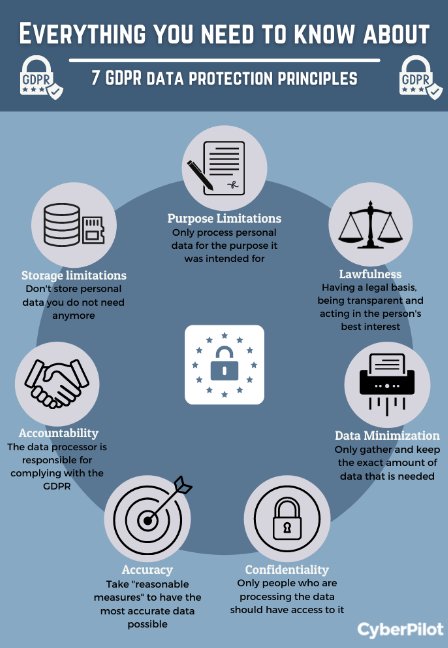In today’s digital age, the amount of personal data being collected and processed has reached unprecedented levels. From social media platforms to e-commerce sites, our personal information is constantly being shared and used for various purposes. However, this convenience comes at a cost – the risk of our data falling into the wrong hands. This is where general data protection comes into play.
General data protection refers to the set of laws and regulations that aim to safeguard the privacy and security of individuals’ personal data. With the increasing number of data breaches and cyber threats, it has become a top priority for governments and organizations worldwide to establish clear guidelines and measures for data protection. In this comprehensive guide, we will delve into the core principles of general data protection, its significance, and its practical implications for businesses and individuals alike.
Understanding General Data Protection
General data protection is based on the fundamental idea that individuals have the right to control their personal data and how it is used. It aims to strike a balance between protecting individuals’ privacy and allowing organizations to collect and use data for legitimate purposes. The concept of data protection gained global recognition with the introduction of the European Union’s General Data Protection Regulation (GDPR) in 2018. Since then, many countries have followed suit and implemented their own data protection laws, such as the California Consumer Privacy Act (CCPA) in the United States.
The primary goal of general data protection is to ensure that personal data is processed lawfully, transparently, and for specific purposes. It also gives individuals the right to access, correct, and delete their data if necessary. Moreover, it outlines strict guidelines for data controllers and processors (organizations that collect and handle data) to follow, including obtaining consent from individuals before collecting their data and implementing appropriate security measures to protect it.
Key Principles of Data Protection
To fully understand general data protection, we must familiarize ourselves with its key principles. These principles serve as the foundation for all data protection laws and regulations and aim to create a harmonized approach towards protecting personal data.
- Lawfulness, Fairness, and Transparency: Data processing must have a legitimate purpose and be carried out in a fair and transparent manner. Organizations must provide individuals with clear information about how their data will be used, and any changes to this use must be communicated promptly.
- Purpose Limitation: Personal data should only be collected for specified, explicit, and legitimate purposes. It should not be processed further in a way incompatible with these purposes.
- Data Minimization: The collection of personal data should be limited to what is necessary for the intended purpose. Organizations must avoid collecting excessive or irrelevant data that could be used to identify individuals.
- Accuracy: Personal data must be accurate and kept up-to-date. Organizations are responsible for ensuring the accuracy of the data they collect and must take measures to rectify any errors or inaccuracies.
- Storage Limitation: Personal data should not be kept longer than necessary for the purpose it was collected. Organizations must establish retention policies and regularly review and delete unnecessary data.
- Integrity and Confidentiality: Organizations must implement appropriate security measures to protect personal data from unauthorized access, loss, or destruction. This includes both technical and organizational measures, such as encryption and access controls.
- Accountability: Organizations are accountable for complying with data protection laws and must keep records of their data processing activities. They must also appoint a data protection officer (DPO) to oversee compliance and handle any data-related issues.
Impacts of Data Protection on Businesses
The implementation of data protection laws has significant implications for businesses. While organizations may initially see it as a compliance burden, there are many benefits to prioritizing data protection. Firstly, it builds trust with customers by assuring them that their data is safe and secure. This can lead to increased customer loyalty and retention. Moreover, complying with data protection laws can also help organizations avoid costly fines for non-compliance.
However, businesses must be prepared to make changes to their data handling practices to comply with data protection laws. Some of the key measures they need to take include:
- Data Mapping: Organizations must have a clear understanding of what personal data they collect, where it is stored, and how it is used. This involves conducting a data inventory and mapping exercise to identify any potential compliance gaps.
- Consent Management: Obtaining consent from individuals is a crucial aspect of data protection. Businesses must ensure that they have valid consent from individuals before collecting and using their data. They must also provide individuals with a way to withdraw their consent at any time.
- Data Protection Impact Assessments (DPIAs): DPIAs involve assessing the risks involved in processing personal data and implementing appropriate measures to mitigate these risks. Organizations must conduct DPIAs for high-risk data processing activities, such as large-scale profiling or processing sensitive data.
- Data Breach Response Plan: In the event of a data breach, businesses must have a plan in place to respond promptly and appropriately to minimize damage. This includes notifying the relevant authorities and affected individuals within the specified timeframe.
Technological Measures for Data Protection
With the increasing use of technology and the rise of cyber threats, data protection has become more complex than ever. However, technology can also be leveraged to enhance data protection measures. Here are some technological measures that organizations can implement to safeguard personal data:
- Encryption: Encryption is the process of converting data into a coded form to prevent it from being read by unauthorized parties. It is an essential tool for protecting sensitive data, such as financial information or medical records.
- Firewalls: A firewall acts as a barrier between an organization’s internal network and external networks, such as the internet. It monitors incoming and outgoing traffic and blocks any suspicious or unauthorized access.
- Multi-Factor Authentication (MFA): MFA involves using more than one method of authentication, such as a password and a biometric scan, to access sensitive data. This adds an extra layer of security and reduces the risk of unauthorized access.
- Data Loss Prevention (DLP): DLP tools can detect and prevent the unauthorized transmission of sensitive data outside an organization’s network. They can also monitor how data is being used within the organization to prevent any misuse.
Best Practices for Personal Data Protection
Data protection is not just the responsibility of organizations; individuals also play a vital role in safeguarding their personal information. Here are some best practices that individuals can follow to protect their data:
- Be cautious about what you share online: Be mindful of the information you share on social media or other online platforms. Avoid sharing sensitive information like your address or financial details, as this information can be used for malicious purposes.
- Use strong passwords: Make sure to use different and complex passwords for your online accounts. Consider using a password manager to generate and store your passwords securely.
- Regularly review privacy settings: Many websites and applications have privacy settings that allow you to control who can see your information. Regularly review these settings and adjust them according to your preferences.
- Beware of phishing scams: Phishing scams involve tricking individuals into giving away their personal information through fake emails or websites. Be cautious of any suspicious emails or requests for personal information and never click on links from unknown sources.
- Keep your devices secure: Make sure to regularly update your operating system and install antivirus software on your devices to protect against cyber threats. Also, avoid using unsecured public Wi-Fi networks to access sensitive information.
Future Trends in Data Protection
As technology continues to advance, so will the need for data protection. Here are some future trends that we can expect to see in the world of data protection:
- Increased Use of Artificial Intelligence (AI): AI has the potential to revolutionize the data protection landscape by automating processes and detecting potential breaches in real-time.
- Stricter Data Breach Notification Requirements: With the increasing number of cyber threats, we may see stricter guidelines on how organizations must respond to data breaches and notify affected individuals.
- Focus on Cross-Border Data Transfers: As data is increasingly being shared across borders, there will be a greater emphasis on ensuring that personal data is protected during transfers between countries.
- Adoption of Privacy by Design: Privacy by design is an approach to data protection where privacy is considered at every stage of a project or process. We can expect to see more organizations incorporating this concept into their operations to ensure data protection from the outset.
Conclusion


The importance of protecting personal data cannot be overstated. As we continue to embrace technology in our daily lives, it is crucial to prioritize data protection to avoid falling victim to cyber threats and fraud. General data protection laws provide a framework for individuals and organizations to safeguard personal data and maintain a balance between privacy and innovation. By understanding the core principles of data protection, implementing appropriate measures, and following best practices, we can all contribute towards a safer and more secure digital world.
